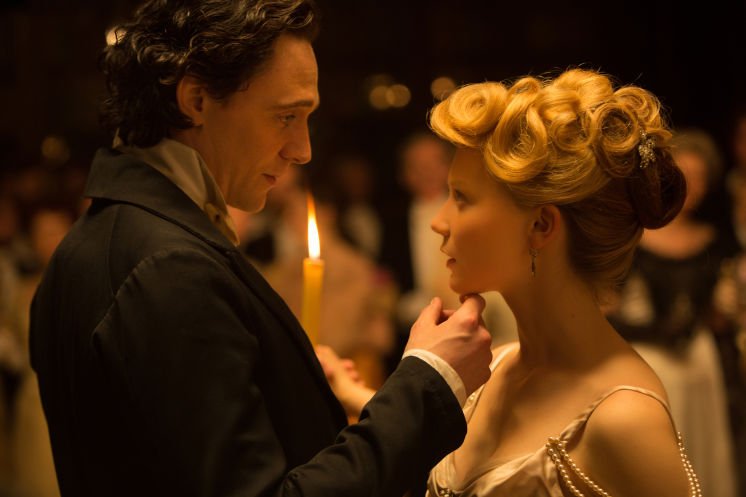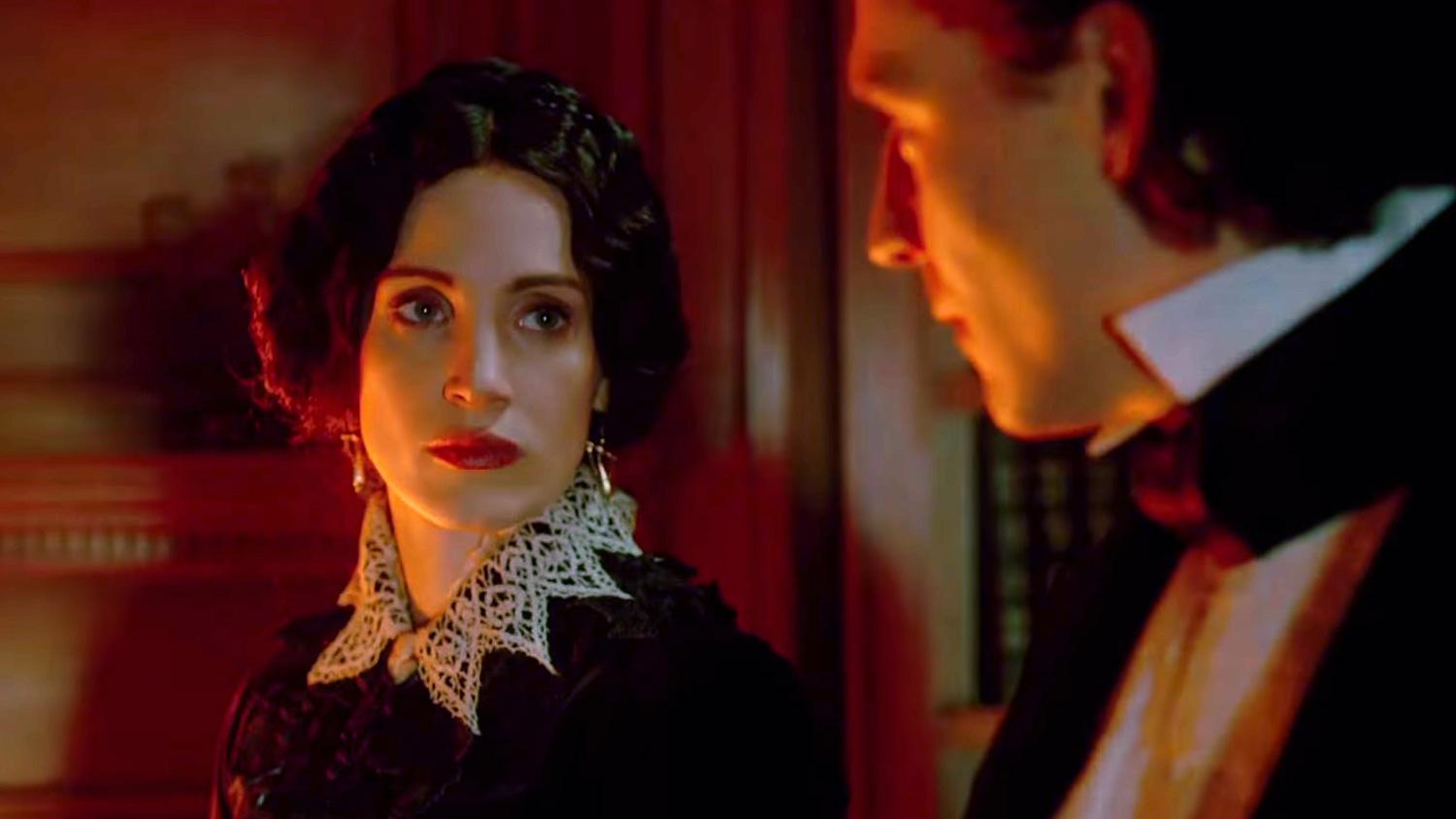Film Review – Crimson Peak Has the Look, But Can It Deliver the Scares?
Directed by Guillermo Del Toro
Starring Mia Wasikowska, Tom Hiddleston, Jessica Chastain and Charlie Hunnam.

Victorian era New York and Edith Cushing, daughter of a wealthy property developer, shies away from the socialite limelight, instead spending her time writing. When mysterious and alluring inventor Sir Thomas Sharpe sweeps her off her feet she finds a love she had only ever written about. Moving to his isolated family home, Allerdale Hall, in Cumberland, England, Edith slowly uncovers the dark past of the Sharpe family and questions the motivations of Sir Thomas’s menacing sister, Lady Lucille.
“Ghosts are real, this I know” – a great opening line, whispered by a blood spattered Edith Cushing as she makes her way through the deep English snow. It’s as intriguing an opening line and image to a haunted house movie as there ever has been and if anyone can make you believe in ghosts then it is the awesomely creative Mexican director Guillermo Del Toro. Responsible for some of the greatest horror fantasies in the last 20 years (Cronos, The Devil’s Backbone and Pan’s Labyrinth), Del Toro has built a career full of visually arresting, intelligent films. Yet Del Toro has two sides to his filmmaking canon, he has cleverly split his output between the Spanish and English languages, creating two very different styles. His engaging, most inventive films are those in the Spanish language, such as the three named above. His more visually aggressive films, his blockbusters, are his English language films, such as Blade II, the Hellboy films and Pacific Rim – all of which are great fun but just a little bit less developed in terms of character and theme, which are often replaced by crash, bang and wallop. This was a conscious decision on Del Toro’s part, a trend he decided to change with Crimson Peak, which he calls his first adult English language film. After the truly awful Pacific Rim, Del Toro needed to change tack – is Crimson Peak the shot in the arm he needed?
A haunted house film is always something to get excited about. I grew up watching The Haunting (1963), Poltergeist (1982), The Shining (1980) and films of that ilk so I have a certain affection for films boasting dark brooding skies, sharp, towering turrets, arched windows, creaking floorboards and strange sounds in the night. One drawback of the haunted house movie is that all of them are virtually the same – it has become a cliché-ridden genre. There are things that you expect, the aforementioned creaking floorboards, the old rambling house, the dark hidden past, the mysterious stranger or the character who isn’t who they say they are. Unravelling these and the anticipation of them is what makes a haunted house movie enjoyable. In Crimson Peak, Del Toro delivers on all of these yet knows that this type of horror film is often found lacking when it comes to originality. Instead of trying to tell an original story, Del Toro focuses on the visual elements and mechanics of how to tell a haunted house film and this is what sets Crimson Peak apart. It is easily one of the most amazing films to look at since Sergio Leone gave us Once Upon a Time in the West. Like Crimson Peak, Leone’s western was more concerned with how it visually told its story than the story itself. Of course this isn’t Del Toro’s first rodeo – The Devil’s Backbone being one of the great Spanish language ghost stories and the one that catapulted Del Toro into the Hollywood stratosphere.

Starting off we are introduced to Edith Cushing (a nice nod to the horror icon Peter Cushing), daughter of a wealthy property tycoon, who wiles away her time writing. Her novel, a story with “a ghost in it and not a ghost story” is close to publication when the mysterious and handsome Sir Thomas Sharpe visits her father looking for investment in his latest venture, a red clay mining project. Her father declines but Sharpe does not leave empty handed, he takes the smitten Edith as his bride back to his rambling ruin of a mansion in Cumberland, England. To this point Del Toro has busied himself crafting a Gothic romance and not a horror film, doing just what his protagonist is aiming to do with her novel, tell a story with ghosts in it as opposed to an out-and-out ghost story. But Edith has a connection to the otherworld, her ability creepily realised in the first few minutes with Del Toro utilising shadows to the absolute max to create a true sense of dread. Told as a flashback, Edith as a child encounters the ghostly apparition of her mother who cryptically whispers “Beware crimson peak.” But the horror ends there, for a while, as Del Toro wisely leaves the supernatural element behind and builds the budding love story between Sir Thomas and Edith. Yet he peppers this first act with intrigue and shade, making the viewer wonder about Sir Thomas and his icy sister Lady Lucille. The mystery builds until they reach England, until Edith crosses the threshold of Allerdale Hall. Almost from the off Del Toro ratchets up the atmosphere, the stunning set and sound design responsible for building a sense of menace throughout the house. Built on blood red clay, Allerdale Hall is slowly sinking, creaking and crumbling into decay, Sir Thomas telling Edith that his father “had to put his back into squandering the family fortune.” With the pipes and the walls oozing blood red, the main reception hall a swirling mix of snow and leaves from the gaping hole in the roof, Del Toro creates an unsettling and sinister atmosphere, layering the mystery with dark tales of family secrets to pique the viewer’s interest.
In terms of architecture and setting, Crimson Peak looks like a cross between Jan de Bont’s remake of The Haunting and Hammer’s recent hit The Woman in Black. Long gothic corridors, dark little nooks and crannies, strange sounds in the night and crippling isolation pepper each and every frame. Thankfully the comparisons to de Bont’s truly awful The Haunting and The Woman in Black end there, as Del Toro does not concern himself with jumpy, cheap scares. There are a few in the film – discovering what is locked in the hidden closet is a zinger – but those types of frights are the exception and not the rule in Crimson Peak. Like Francis Ford Coppola before him, with the underrated Bram Stoker’s Dracula, Del Toro builds tones and hues and embraces the little visual ticks that were common to early era cinema, the screen wipes and the iris fade outs are beautiful to see. Unfortunately, and totally out of character for the director, Del Toro finds himself relying more and more on CGI. A strong advocate of make up and costume effects, Del Toro uses CGI to create the vaporous, spectral being that haunts the ruined mansion. It is here that his touch seems to desert him as once we see this ghost then all fear and tension drains away. The carefully built atmosphere seems to dissolve into the architecture. Yet Del Toro seems to realise this himself as the film then begins to shifts focus to the sinister motivations of the humans and not those of the spirits and ghosts.

In terms of acting, Crimson Peak boasts with three strong performances from Wasikowska, Hiddleston and Chastain. While Wasikowska’s Edith Cushing is the chief protagonist, as the film progresses you find that Hiddleston’s Sir Thomas and Chastain’s Lady Lucille present the dark heart of this story, the mystery and the intrigue. Chastain in particular channels Annie Wilkes and Norma Bates to great effect as she builds the twisted Lady Lucille. Though only a supporting character, she steals the show. Charlie Hunnam, of Sons of Anarchy and Pacific Rim fame, only seems tacked on. The character is very one-dimensional and serves no real purpose other than as a rival for Edith’s affections.
While praising Del Toro for his visual ingenuity, he falls down in one major category. Crimson Peak is not really that scary. Yes it is unsettling in places and yes you will jump in places but those are few and far between, it just does not have enough catch-your-breath moments. While the scares let you down, unfortunately the romance element is not strong enough to sustain Crimson Peak either and it gets caught in a strange place that is neither horror film nor love story. Focusing almost exclusively on the visuals and the setting, Del Toro has dropped the ball when it comes to the punch, spending his time populating each frame with beautiful, brooding imagery. The twists are easily spotted and the plot devices, designed to propel the story forward, can be guessed at. With a film as eerily beautiful as this you just wish there had been more in the tank and more put into the story.
Crimson Peak is a horror/romance film without any real horror or any real romance. Its strong and carefully built atmosphere is not enough to sustain it in the fright department but it is as Del Toro promised, his first adult English language film as Crimson Peak deals with some very dark subject matter. Taking inspiration from various horror maestros, Del Toro tries his hand at emulating Hitchcock and FW Murnau and creates a film rich in visual flair but sadly lacking in substance. An interesting film to watch, don’t expect Crimson Peak to scare the bejesus out of you. Though released in time to catch the Halloween buzz, it is not a frightfest. If you want cheap thrills then go see the latest teen slasher or Paranormal Activity 21 (or whatever one they are on now); if you want to watch a beautifully crafted and atmospheric film instead then Crimson Peak may just be for you.
Crimson Peak is in cinemas now. Check out the trailer here.
Featured image credit: ihorror.comc

